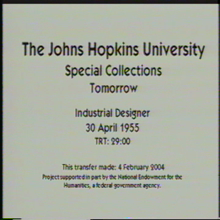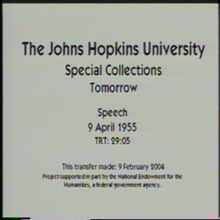Abstract:
Raymond Loewy the Father of Industrial Design defines his profession as one that designs products for mass production Simplicity and functionality are key in his designs of packaging service centers uniforms household goods modes of transportation and other functions Mr Loewy who came to the United States in 1919 displays some of his product designs such as the Lucky Strike cigarette package an electric heater with better stability a bathroom scale with improved legibility a silent eggbeater a safe pressure cooker a bottle with antislip grip inexpensive but tasteful flatware and other items He comments on designs typically found in rooms in 1900 and 1926 and shows how theyve been improved His 1951 book Never leave well enough alone recommends simplifying goods and improving them to lower their manufacturing costs Designer of the Studebaker car Loewy shows cartoons of overdone cars with dagmars and others influenced by airplane designs
Date Published:
1955-04-30
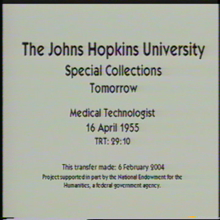
Abstract:
As an introduction to this programs career Lynn Poole notes that it was announced this week that the Salk vaccine is effective in preventing polio He also points out that in 1890 Dr M Cary Thomas was only allowed to attend classes at Johns Hopkins University if she sat behind a screen because she was a woman in a mens institution But this program features Isabelle Schaub assistant professor of microbiology at that university and author of the Diagnostic bacteriology textbook She introduces a number of young women and describes their laboratory job functions in the fields of bacteriology biochemistry hematology serology and histology Brief film clips from the National Committee for Careers in Medical Technology show the processes of preparing slides of body tissues and studying blood cells under a microscope Ms Schaub lists three ways to enter the field as an entry level lab aid as a recipient of the American Society of Clinical Pathologists certificate or as a college graduate
Date Published:
1955-04-16

Abstract:
The program opens with a brief history of the evolution of metal and its uses in early tools utensils weapons and ornaments In 1900 only sixteen kinds of metal were used by American industry but at the time of this program there are 321 known metals and alloys Lynn Poole shows a piece of a new metal Fiberfrax that doesnt get hot when heated Dr Maddin associate professor of metallurgy at Johns Hopkins University discusses the inside of metal and shows a model of atoms in a perfect metal and one with deviations or imperfections Mr Poole notes that only 460 metallurgists are being trained in 45 colleges each year but at least three times that number are needed each year for the next ten years Dr Hollomon head of the metallurgy and ceramic research division of General Electric GE lists common metal products and discusses how metals such as titanium alloys must be made stronger to withstand the higher temperatures occurring at faster jet speeds and to solve the problem of fractured pipelines and ships There are career opportunities for chemist metallurgists involving ingots and arch melting process metallurgists researching the forces in metals development metallurgists testing stresses and corrosion of metals and research metallurgists looking inside metals Dr Hollomon recommends studying math physics and chemistry in high school to begin the path to becoming a metallurgist Dr Vannevar Bush president of the Carnegie Institution promotes the benefits of this forthcoming Johns Hopkins career series and comments on the applications of modern science to the improvement of life The pamphlet A Career in Metallurgy is offered to viewers for a postcard
Date Published:
1955-03-26
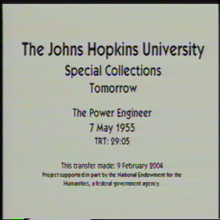
Abstract:
An opening film explores electricitys timeline sparks created from rubbed amber William Gilberts study of magnetism Benjamin Franklins demonstration of lightening as electricity in 1752 Alessandro Voltas first electric battery and Thomas Edisons 1879 incandescent electric light Willis Gore Johns Hopkins University assistant professor of electrical engineering points out that an engineer both creates or invents and operates what he has produced He uses a servosystem to demonstrate two branches of electric engineering communications electronics and power generation and utilization of power Thomas Trice superintendent of electrical operations of Baltimore Gas and Electric says that electrical engineering has emerged as a leading profession as electrical demand has increased dramatically since 1910 A film of the electrical planning process stresses reliability of service safety and cost of a design An electrical power analyzer is shown and explained as are meters and relays designed for accuracy and dependability at the Herbert A Wagner electric generating station in Baltimore Another film follows the generation of electricity from the coal pile through an electrical power plant and over wires to various customers George Bisset senior vice president of Potomac Electric Power Co in Washington DC discusses the shortage of electrical engineers noting that atomic energy will not replace electrical energy and that use will at least double every ten years He recommends that interested students take physics and math courses and consult a vocational counselor college or local electric company for additional advice The profession offers prestige satisfaction and good compensation and working conditions
Date Published:
1955-05-07

Abstract:
After a brief photographic and cartoon history of crop cultivation problems Lynn Poole touts the variety of jobs and opportunities in chemistry Dr Iler research manager of the Grasselli Chemical Dept at E I duPont de Nemours and Co defines chemistry and chemical reactions and lists everyday products created from chemical reactions In agriculture fertilizers insecticides fungicides herbicides and feed supplements for livestock and poultry are all chemical creations The process to develop a new product involves organic chemists physical chemists analytical chemists biologists chemical mechanical and electrical engineers and often soil chemists and biochemists A film shows how research results applied to farm production result in greater output with less labor The goal of agricultural research chemists is to create new knowledge processes and products and improve present ones for plants and animals Dr Iler notes that 90 of all chemicals tested are inadequate He then explains the steps required to test a new fungicide chemical beginning with making the chemicals easily mixable with water for spraying on plants and ending with analysis of the resulting fruit with a colorimeter to test for chemical absorption He also briefly comments on chemicals in cattle dips and sprays to control insects and parasites on livestock Dr Iler says that curiosity a background in math and sciences and a college degree are necessities to become a chemist or chemical engineer Mr Poole makes available the booklet Chemistry and the Farmer for a postcard
Date Published:
1955-05-28
Abstract:
Archaeology is the recovery and study of the material objects of past civilizations for the purpose of reconstructing these civilizations to study them more fully Archaeologists put these objects in their proper period and use them to explain the ways of ancient life Modern archaeology began with Heinrich Schliemann and his discovery of Troy Dr Young shows a reconstruction of a farm in ancient Greece and the ruins of a temple at Sounion At DuraEuropos in Syria remains of three religions were found a Christian chapel a Jewish synagogue and a temple of the cult of Mithras Students of archaeology must study the languages and history of the civilizations they are studying along with the technical aspects of archaeology
Date Published:
1955-04-02
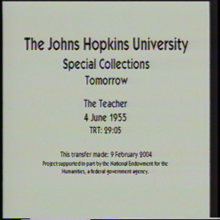
Abstract:
George Schwartz a science teacher at Forest Hills High School in Long Island NY discusses the teacher shortage and the complexity of the profession Teaching is more than just being well informed because it involves personal relationships Mr Schwartz shows how a teacher must be a showman to demonstrate scientific principles in ways students wont anticipate such as pulling paper from beneath a full beaker of water to prove the rule of inertia To prove that a teachers influence affects eternity Lynn Poole interviews four of Mr Schwartzs former students Dr Richard Lewontin an assistant professor of genetics at North Carolina State College a high school senior and budding herpetologist a third year medical student at Harvard Medical School and a freshman majoring in biology at Queens College All praise their former teacher and explain how he had influenced them Mr Schwartz lists the requirements of a good teacher subject knowledge love of young people boundless energy and selfcriticism
Date Published:
1955-06-04
Abstract:
Lynn Poole points out that retailing is the second largest industry in the United States Albert Hutzler Jr president of Hutzler Brothers Co considers his department store careers unlimited because of the great opportunities at all levels He introduces his merchandise manager Robert Wittington who discusses various departments focusing on the fashion buyer and rug buyer They explain their jobs which include planning months ahead and anticipating style trends and customers wants Mr Poole talks with a saleswoman who has worked in the linen department for 28 years The superintendent of advertising Adelaide Dillehunt discusses the process of creating a newspaper ad and introduces the departments artist and copywriter adding that direct mail radio magazine and TV ads are also necessary The companys display manager explains visual merchandise presentation noting the various workshop occupations required to create window and interior displays
Date Published:
1955-05-21
Abstract:
The program opens with an historical look at the Delsarte method of elocution and silhouetted examples of mannerisms and gestures that were taught to be coordinated with the voice Short dramatizations show several scenes in which effective or ineffective speech affects peoples careers Lynn Poole listens to his own tape recorded voice Elton Mears speech instructor at John Hopkins University discusses examples of successes in public speaking He says that inexperienced speakers make three speeches the one they planned to make the one they make and the one they wish theyd made He points out that attitude poise preparation knowledge and organization of the subject all play important roles in speech making as do eye contact and body language He recommends only conveying what is worthy of communicating stand up speak out shut up sit down Joseph H Purdy Director of Public Relations for a Baltimore utilities company comments briefly on differences between the written and spoken word
Date Published:
1955-04-09

